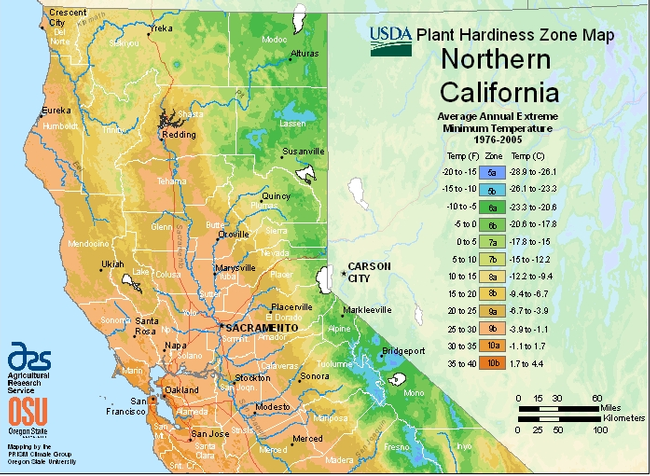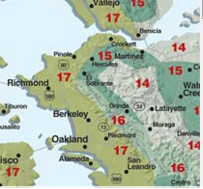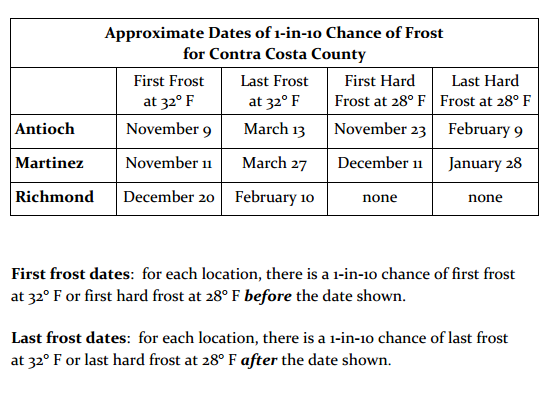Advice from the Help Desk of the
UC Master Gardeners of Contra Costa County
Client's Requests:I'm a new veggie gardener in Contra Costa County (CCC). Would you please help me with some basic veggie growing information for CCC:
- Planting zone for my area
- Last frost date for my area.
- Best veggies to plant for my growing area
- List of germination times for various vegetables such as lettuce and radishes.
MGCC's Help Desk Response:
Thank you for contacting MGCC. We believe the information below should answer your questions about veggie gardening no matter where you live in CCC. We also believe all of the information you seek is readily available on the web either from interactive maps based upon government or authoritative information or downloadable from our own MGCC or other UC web sites.
The responses below are in the order of your request:
for Northern California
The US Department of Agriculture's Plant Hardiness Zones are used throughout the U.S. Here in CCC the majority of the residential part of CCC is divided into only two zones, either 9 (the majority) or some of the milder SF Bayside areas it would be Zone 10. Both zones can be further split (e.g. 9a and 9b) where the “a” zone is colder. (The colder the winter, the lower the USDA Zone designation). A web-based interactive map based upon the USDA Zones can be found at http://planthardiness.ars.usda.gov/PHZMWeb/InteractiveMap.aspx. This interactive map allows you to put in your zip code and get your USDA Plant Hardiness Zone. There are some other interactive maps on the web as well that based upon USDA data. One that I like to compare data with can be found at http://www.plantmaps.com/interactive-california-usda-plant-zone-hardiness-map.php.

for western CCC
2. Last frost date: The Last Frost Date (LFD) is important as it is an indicator to determine when your tender transplants and/or your seeds can go in the ground without protection from the cold. (Note: Soil temperature is also a consideration and can be measured with a soil thermometer about 3” below ground surface. Soil temperature guidelines can be obtained from the reference in response 4. below). As with Plant Hardiness Zones, the LFD also varies considerably throughout CCC. As a rule-of-thumb, MGCC usually recommends that on average you protect your plants for frost (and even possible freezes) from at least mid-November to mid-March. But, “all weather is local” and frost dates are no exception. Micro-climates, can also be a consideration. Micro-climates are local effects on a small area that can be either natural or man-made, e.g. different temperatures leading to frosts if you are located on a hill or down in a valley, or in the garden if there is no cover. In my garden, the narrow area between the fence and house rarely sees frosts, while the open garden on the back hillside gets frost regularly during the winter. The MGCC last reviewed our LFD in 2010 and the results can be found at http://ccmg.ucanr.edu/files/51309.pdf. The summary results are shown below:

3. Best Veggies: MGCC has reviewed and recommended “best veggies” for planting in CCC several years ago. The results, with links below, are based upon SF Bayside veggie gardening vs. the remainder of the County (Inland):
* Contra Costa County Vegetable Planting Guide for Interior Regions http://ccmg.ucanr.edu/files/131284.pdf
* Contra Costa County Vegetable Planting Guide for Coastal Regions http://ccmg.ucanr.edu/files/131285.pdf
4. Vegetable germination times: Success in propagating veggie seeds is usually determined by noting if/when your seeds sprout and are on their way to becoming seedlings and eventually full-fledged veggies. Necessary soil temperatures and germination times for almost every home garden vegetable imaginable is found on the UCANR web siteUCANR document at http://ucanr.edu/sites/sacmg/files/164220.pdf.
Hopefully, the above answers your questions on getting started in your veggie garden this year. Please do not hesitate in contacting MGCC if you have further questions.
Help Desk of the UC Master Gardeners of Contra Costa County (SIM)
Note: The UC Master Gardeners of Contra Costa's Help Desk is available year-round to answer your gardening questions. Except for a few holidays, we're open every week, Monday through Thursday for walk-ins from 9:00 am to Noon at 75 Santa Barbara Road, 2d Floor, Pleasant Hill, CA 94523. We can also be reached via telephone: (925) 646-6586, email: ccmg@ucanr.edu, or on the web at http://ccmg.ucanr.edu/Ask_Us/ MGCC Blogs can be found at http://ccmg.ucanr.edu/HortCoCo/ You can also subscribe to the Blog (//ucanr.edu/blogs/blogcore/blogroll.cfm).